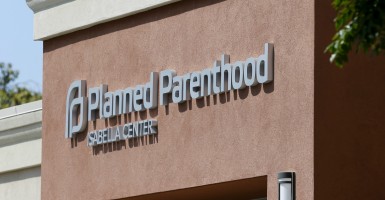Recent undercover videos showing Planned Parenthood employees haggling over the price of body parts from aborted babies have renewed calls to end all federal funding of the nation’s largest abortion provider.
With the Senate’s failure to pass a standalone bill prohibiting funding of the organization this week, all eyes have turned to the appropriations process this fall and a possible continuing resolution as a vehicle for ending the flow of tax dollars to Planned Parenthood.
But some are now questioning whether that’s even possible.
Senate Majority Whip John Cornyn, R-Tex., has said removing federal funding from the organization “is a little more complicated” because, as the Washington Examiner notes, “much of the organization’s share of [$528] million in federal funding comes from Medicaid, which is mandatory spending not annually appropriated by Congress.”
But that assertion fundamentally misstates how Medicaid receives federal tax dollars. Unlike other entitlement spending, Congress actually funds the Medicaid program through the appropriations process each year.
As a Congressional Research Service (CRS) report explains:
While most mandatory spending programs bypass the annual appropriations process and automatically receive funding each year according to either permanent or multi-year appropriations in the substantive law, Medicaid is funded in the annual appropriations acts. For this reason, Medicaid is referred to as an ‘appropriated entitlement.’ …While most changes to the Medicaid program are made through statute, the fact that Medicaid is subject to annual appropriations process provides an opportunity for Congress to place funding limitations on specified activities in Medicaid, including the circumstances under which federal funds can be used to pay for abortions (emphasis added).
This allows Congress to use the “power of the purse” to change or condition funding under the Medicaid programs through each year’s appropriations.
Indeed, every year since 1976, Congress has attached the Hyde amendment to appropriations for the Department of Health and Human Services, prohibiting federal funding of elective abortion procedures, except in cases of rape, incest, or when the mother’s life is in danger. That longstanding and widely supported policy applies to all federal Medicaid funding.
Even outside of the Medicaid program, Congress routinely ends or limits other sources of mandatory spending during the appropriations process. In fact, changes in mandatory spending are often used by appropriators to try to hide increases in overall spending.
Disqualifying Planned Parenthood from receiving federal Medicaid reimbursements would not decrease the amount of overall funding available for women’s health services. There are roughly 9,000 federally qualified health center service sites across the country that can provide women’s health services, in addition to a wider range of primary care – and that don’t perform abortions. Federal Medicaid funding could still flow to those (and other) qualified health providers.
Congress has the power to stop all federal funding of Planned Parenthood during the appropriations process this fall. Policymakers owe it to the taxpayers who have bankrolled the organization for too many years to move quickly to prohibit federal funding of Planned Parenthood.
An organization that performs nearly 1 out of every three abortions in the United States and stands accused of selling tiny organs from those aborted children for a profit, spurring both state and congressional inquiries, does not deserve the hard-earned dollars of American taxpayers.
































